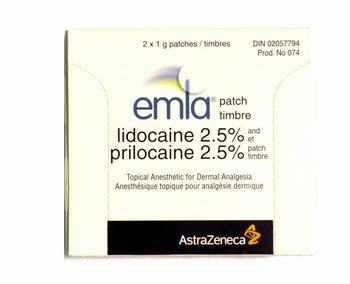EMLA cream
EMLA (an acronym for Eutectic Mixture of Local Anesthetics) is a topical anesthetic—that is, a cream or patch that can be applied to the surface of the skin to numb it.
EMLA contains two commonly used local anesthetics: lidocaine and prilocaine. The combination is anaerobic, meaning it needs to be isolated from air during activation. This is done by use of an occlusive bandage: either a Tegaderm patch, which often comes with the EMLA, or something like saran wrap.
On regular skin, EMLA cream takes about 45 minutes to fully penetrate—but on mucous tissues such as a urethra or glans, the hour wait is often unnecessary as it will penetrate immediately. This numb area means that the pain from a needle puncture procedure is significantly minimized, and often eliminated. Some examples of needle puncture procedures would be injections, piercings, and tattooing.
Many people will claim that tattoos and piercings "don't hurt enough" to warrant pain control, but everyone's threshold is different and it may be considered necessary for others.
It should be noted that while EMLA cream is over-the-counter in Canada and Australia, it is a prescription-only substance in most countries, including the US. In addition, its application may be illegal for piercers or tattooists to perform.
However, it's also interesting to note that while EMLA, a 2.5% strength product is banned OTC in America, products with strengths of 5% or more are available no-questions-asked in sex shops sold as orgasm retardant creams—it's all about context!
You can purchase EMLA online at BMEshop.
